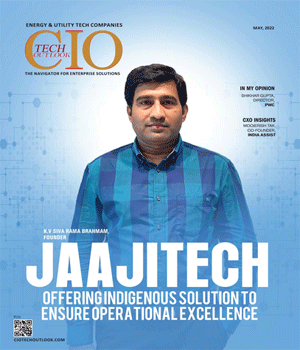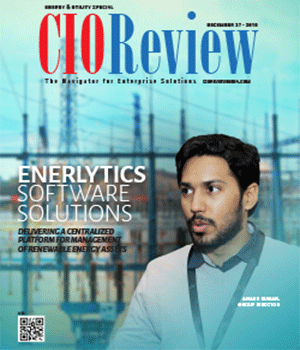
Value of an IT PMO
CIOReview Team | Friday, 29 May 2015, 09:55 IST
 Changes in the energy markets and in technology are evolving rapidly and challenging the ability of Information Technology (IT) organizations to demonstrate value to their business counterparts. The lack of perceived value among an organization’s business stakeholders may jeopardize continued support for IT and its initiatives. As a result, it is critical that IT produce successful customer-facing business value and communicate the benefits to all stakeholders in order to build credibility and trust. An IT Program Management Office (PMO) when deployed effectively can be a powerful method to help the IT organization manage change through improved planning, execution and communication by promoting a culture of collaboration and continuous improvement.
Changes in the energy markets and in technology are evolving rapidly and challenging the ability of Information Technology (IT) organizations to demonstrate value to their business counterparts. The lack of perceived value among an organization’s business stakeholders may jeopardize continued support for IT and its initiatives. As a result, it is critical that IT produce successful customer-facing business value and communicate the benefits to all stakeholders in order to build credibility and trust. An IT Program Management Office (PMO) when deployed effectively can be a powerful method to help the IT organization manage change through improved planning, execution and communication by promoting a culture of collaboration and continuous improvement.
If IT is going to be successful in a dynamic and changing business environment, then its leaders need to develop the organization’s capability to be resilient and productive in the face of the ever increasing rate of change. Energy industry experts are warning that trends in consumer demand, technology, global climate change and competitive forces are threatening to disrupt the power industry’s traditional business model and will eventually force radical change and disruption on the industry.
A PMO when effectively employed can be a useful tool for IT leaders within the energy industry, to proactively plan and exploit potentially far reaching developments occurring now and in the future. Without effective planning, reasonable action may be postponed until changes overtake us and force us to react with reduced or limited options.
Edward Deming, regarded as a founder of Total Quality Management says, “Put a good person in a bad system and the bad system wins, no contest.” Although proven to be effective in many industries and in a variety of environments, the concept of a Program Management Office (PMO) is often misunderstood, misapplied and in the worst cases abandoned altogether by organizations as a “bad system”, reinforcing prejudicial notions that it is unproductive, ineffective and expensive overhead.
“To control IT costs, the organization needs to work together consistently, and a strong PMO can facilitate the process”
Effectively managing radical change is not something that comes easy to traditional information technology organizations. The practical reality in many organizations is that the scope of critical functions like planning, prioritization, budgeting and execution are performed within functional unit boundaries and are not necessarily aligned with wider organizational goals and plans. Functional silos have evolved over time and become part of the organization’s “legacy” environment.
Many companies have a loose arrangement of disconnected management processes concerning IT planning. Investment in IT and on-going expenditures are not directly aligned with or in direct support of business strategies. Often senior managers are unable to identify what value is provided from their investments. At the same time, IT managers are frustrated by their inability to communicate the benefits of IT initiatives to their business counterparts. This disconnect severely constrains the flexibility of the business to respond effectively to changes in the environment and ultimately limits operational effectiveness.
To succeed, IT leaders need to evaluate if they are in fact operating in a “bad” system. As IT leaders, we need to understand how to leverage the influence of our own IT business within the larger mission that we support in order to position the IT organization as a positive force for change and improvement within the larger business organization and to play an effective role in supporting the larger business strategy and its ultimate survival.
Effective planning processes are critical, and the PMO can help. In order to control IT costs, produce higher business value and bottom-line impact, organization needs to work together consistently, and a strong PMO can facilitate the process. IT management must control IT budgets and investments and at the same time improve IT’s impact on the bottomline by systematically selecting the best IT investments, and eliminating under-performing IT activities. This can only occur when all participants in the process share a common culture and set of values.
To be successful, key organizational stakeholders must view the PMO as a method for bridging organizational boundaries and aligning functional goals with enterprise strategy and common goals. Successful organizations often refer to their implementation as a “guiding coalition”, “steering committee” or “true believers”. In many ineffective PMO implementations or “bad systems”, the fundamental principles of organizational learning, organizational change and continuous improvement are ignored or at best considered as an afterthought in favor of an overly rigid, technical, cook book style implementation approach.
Although there are many frameworks or methodologies available for PMO implementation, the foundation of a successful and sustainable PMO must rest on a shared understanding of the spirit of the PMO and must be reinforced and institutionalized by its roles, responsibilities and practices. Fundamentally, the essence of or spirit of the PMO is best seen in the behavior and values of the stakeholders. It must not be mistaken for the process or procedural details. The success or failure of a PMO implementation should be based on the results that are achieved for the business and not on an adherence to a particular model or guideline.
The true value of a successful PMO is demonstrated by the culture and values of the organization and its stakeholders. It can be recognized by observing the behavior of its participants in conducting their day to day business. Someone once stated, that a successful PMO culture is said to exist when stakeholders demonstrate a healthy respect for both a dollar and a minute of time in expending the organization’s resources.
CIO Viewpoint
Digital Disruption - To Drive Next Wave Of...
By Jatinder Bansal, AVP & Head IT, ReNew Power Ventures Ltd
IT Services Outsourcing - Challenges to Conquer
By Umasankar Pandurangan, AGM- IT, HPCL- Mittal Energy Limited
Hadoop Uncovering Hidden Patterns to Make...
By Priyadarsanie Ramasubramanian, Head - Engineering and Technology, Tesco
CXO Insights
What is SF6 and why is it important?
By Guilherme Susteras, IEEE Senior Member
Unlocking Growth Via Digitalization Of The...
By Shikhar Gupta, Director, PwC
From Power to Lifestyle - The Future of Solar...




.jpg)
.jpg)




